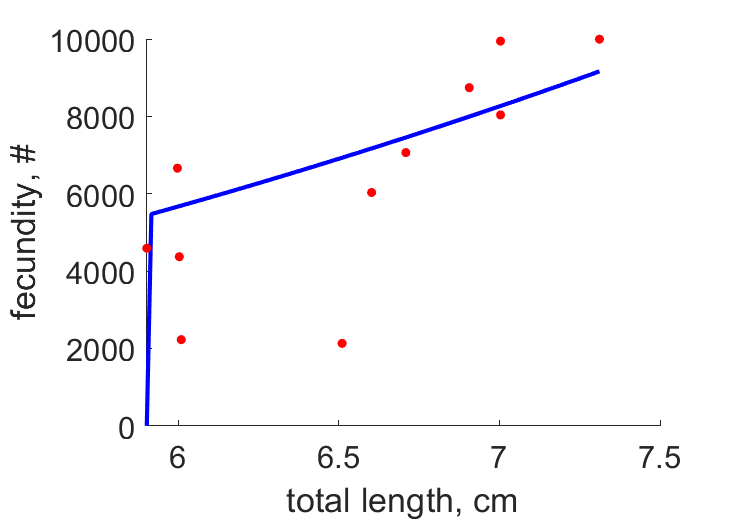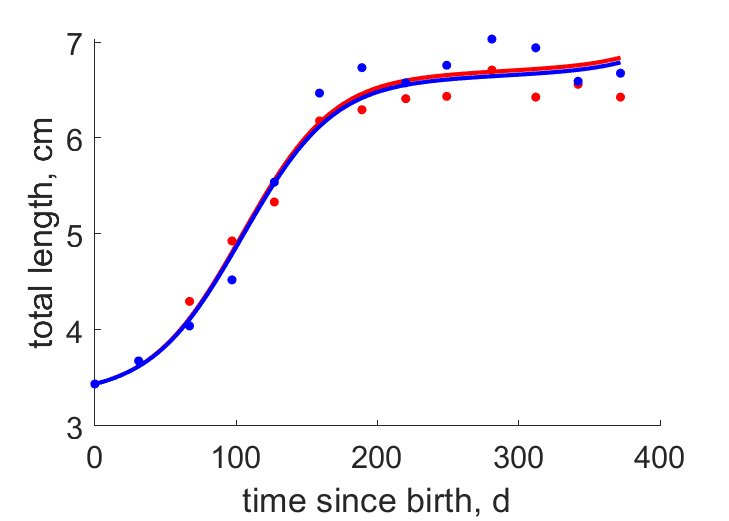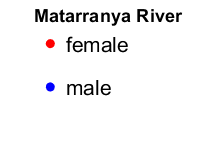Predictions & Data for this entry
| Model: abj | climate: Cfb, Dfa, Dfb | migrate: Mp | phylum: |
| COMPLETE = 2.5 | ecozone: THp | food: biCi | class: |
| MRE = 0.053 | habitat: 0iFm, 0iFp | gender: D | order: |
| SMSE = 0.014 | embryo: Fh | reprod: O | family: |
Zero-variate data
| Data | Observed | Predicted | (RE) | Unit | Description | Reference |
|---|---|---|---|---|---|---|
| am | 2555 | 2562 | (0.00266) | d | life span | fishbase |
| Lp | 5.8 | 5.827 | (0.004594) | cm | total length at puberty | VinySost2010 |
| Li | 21 | 21.68 | (0.03246) | cm | ultimate total length for females | fishbase |
| Lim | 21 | 21.3 | (0.01427) | cm | ultimate total length for males | fishbase |
| Wwb | 0.00011 | 0.0001187 | (0.07905) | g | wet weight at birth | VinySost2010 |
| Wwp | 2.13 | 2.037 | (0.04383) | g | wet weight at puberty for females | VinySost2010, fishbase |
| Wwi | 108 | 104.9 | (0.02834) | g | ultimate wet weight for females | fishbase |
Uni- and bivariate data
| Data | Figure | Independent variable | Dependent variable | (RE) | Reference |
|---|---|---|---|---|---|
| LN |  | total length | fecundity | (0.289) | VinySost2010 |
| tL_fm |   | time since birth | total length | (0.0285) | VinySost2010 |
Pseudo-data at Tref = 20°C
| Data | Generalised animal | Barbatula barbatula | Unit | Description |
|---|---|---|---|---|
| v | 0.02 | 0.01665 | cm/d | energy conductance |
| p_M | 18 | 13.01 | J/d.cm^3 | vol-spec som maint |
| k_J | 0.002 | 0.0007771 | 1/d | maturity maint rate coefficient |
| k | 0.3 | 0.3137 | - | maintenance ratio |
| kap | 0.8 | 0.8018 | - | allocation fraction to soma |
| kap_G | 0.8 | 0.7969 | - | growth efficiency |
| kap_R | 0.95 | 0.95 | - | reproduction efficiency |
Discussion
- Males are assumed to differ from females by {p_Am} only
- Seasonal cycle in temperature in tL data was assumed: T(t) = 15+15*sin(2*pi*(t-t_0)/365)
Facts
- length-weight: Ww (in g) = 0.01*(TL in cm)^3.05 (Ref: fishbase)
Bibliography